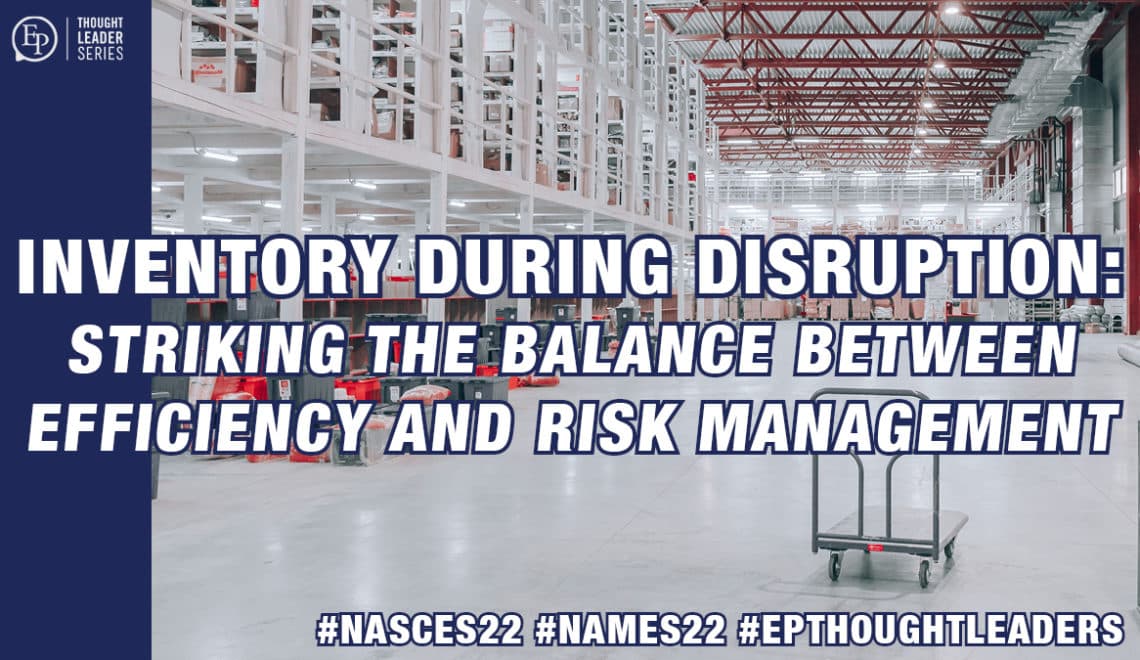
There are many ways of thinking about inventory.
For sales and operational planners and demand forecasters, inventory prompts the eternal ongoing questions: How much do we need? Where do we need it? When will it be needed there?
For supply chain executives, the questions are often broader: Where is it coming from? Where is it right now, and in what condition? How is it getting from point of origin, through our distribution network, to its destination? What plans do I have in place if the answer to any of those questions change?
For manufacturers, inventory is usually thought of in a negative light: Inventory is where a company’s capital is tied up somewhere in the value chain until it becomes either profit or loss, and the longer it sits, the less likely it is to offer a return on its investment.
One of the great triumphs of many world-class manufacturers was successfully building a JIT (Just-in-Time) inventory management system where things only arrive where they are needed as they are needed in the quantity and quality that they are needed to keep the manufacturing process working. To cite the most obvious example, when Toyota builds a car, the assembly line only has the parts needed for the vehicles on it. There is no bin heaping with ‘extra parts’ behind each station on the line. Toyota has optimized their assembly line to the point where many books have been written about it, and many careers have been made in other companies as leaders take the lessons learned from Toyota’s example to eliminate waste in their own business processes, especially as it relates to excess inventory piling up where it is not needed.
Roughly speaking we are now two years into a worldwide disruption the likes of which the modern global economy has never seen before, and there is no definitive end in sight. What has that done to how people think about inventory? Which standard operating procedures have failed to deliver their usual tried, tested, and true results in these unusual circumstances? What new innovations are being created to take their place?
While every company is different, the overwhelming trend seems to be that Risk Management requires more inventory.
Sales and operational planners and demand forecasters have seen enormous changes in customer behaviour and expectations, and while more inventory is not necessarily the best solution to all those changes, we have all seen how empty shelves and slow deliveries dominate news cycles, sour brands, and perhaps most importantly leave potential revenue on the table.
Supply chain executives, meanwhile, are needing to rethink their sourcing, their distribution, and their fulfillment efforts in a new business reality where ports and borders many close, warehouses and factories can be shuttered, and workers and drivers are in short supply, all seemingly without warning. Add to this the idea that the team that stays on top of transparency, visibility, flexibility, and agility are now doing their jobs in a very different daily working environment than they were two years ago. Much has changed, and the luxury of excess inventory as a safety net and an emergency resource that allows room to maneuver when things suddenly change somewhere in the system is a much more attractive option than it was before the global pandemic.
As for manufacturers? A far dirtier industry term than inventory is unplanned downtime. If the super-efficient assembly line optimized over years of daily Continuous Improvement efforts stands idle unexpectedly because there are no parts to assemble or raw materials to process, that is a far greater loss in productivity than having more than you need at any given time. In a disrupted world where supply chains are not as reliable as they once were, is it not better to have more than you need stored somewhere on the facility’s property so you can keep working while waiting for further supplies to be delivered and finished goods moved on down the value chain?
In times of disruption, risk management almost always dictates more inventory is better than less inventory, and the current global disruption has been running long enough now to create a ‘new normal’ not just for how people work, but for how they think about inventory.
Here are a few questions to ask about how your business thinks about inventory:
- How has your organization’s inventory management changed since the outbreak of COVID-19?
- Were those changes done reactively or proactively? Have those changes been re-examined as your company has moved from the ‘fighting fires’ stage of crisis management and into the ‘lessons learned’ stage?
- Inventory optimization was always a moving target even before the global pandemic. Do you find the changes you have put in place are improving your organization’s responsiveness to change? Is that improved agility and flexibility worth the cost of the changes you have made to your pre-COVID inventory management system? If the global disruption ended tomorrow, which ‘temporary’ changes would you make permanent?
- Inventory is about capital. Changing inventory policy impacts financial performance. Will the people responsible for explaining the bottom line to shareholders and stakeholders explain the inventory changes as a regrettable necessity, or a positive innovation in proactive Risk Management? The company line will steer how these inventory decisions are thought of in the future. Who among your company’s sales and operational planners, demand forecasters, and supply chain and manufacturing leaders contribute to how their new processes will be communicated outside their own departments?
—

Geoff Micks
Head of Content & Research
Executive Platforms
Geoff joined the industry events business as a conference producer in 2010 after four years working in print media. He has researched, planned, organized, run, and contributed to more than a hundred events across North America and Europe for senior leaders, with special emphasis on the energy, mining, manufacturing, maintenance, supply chain, human resources, pharmaceutical, food and beverage, finance, and sustainability sectors. As part of his role as Head of Content & Research, Geoff hosts Executive Platforms’ bluEPrint Podcast series as well as a weekly blog focusing on issues relevant to Executive Platforms’ network of business leaders.
Geoff is the author of five works of historical fiction: Inca, Zulu, Beginning, Middle, and End. The New York Times and National Public Radio have interviewed him about his writing, and he wrote and narrated an animated short for Vice Media that appeared on HBO. He has a BA Honours with High Distinction from the University of Toronto specializing in Journalism with a Double Minor in History and Classical Studies, as well as Diploma in Journalism from Centennial College.











